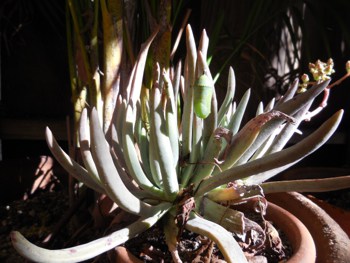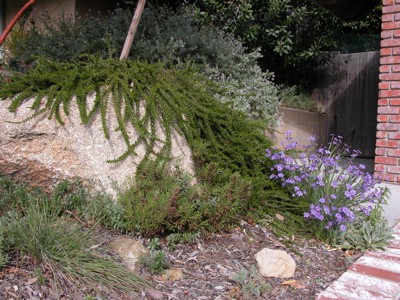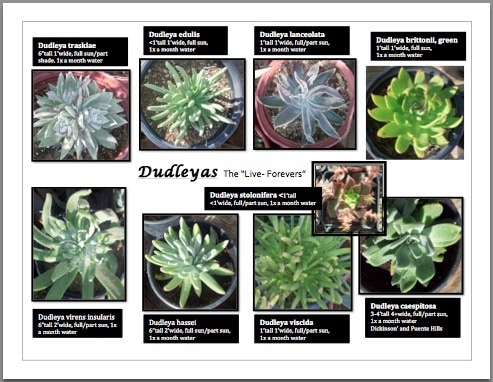Dudleya: California Live-Forever
Tree of Life Nursery’s own contract specialist, Suzie muses about Dudleya…
California’s native succulents, like Transformers™, are more than meets the eye. Or so my colleague describes them… And though sort of nerdy (yet trendy at the same time), the pop culture reference does fit these little native accents!

The live-forevers, genus Dudleya, are a group of plants that offer us an opportunity to be amazed at seasonal changes. Like many native plants, the Dudleyas have the ability to take what nature gives them and survive! In nature they seem to hang effortlessly from crevices on cliff faces. After fading during the dry months, many of these plants appear out of nowhere emerging from their dormant shadow during the rainy season. The semi desiccated dormancy allows Dudleyas to withstand the dry season and as a bonus adds, what one may call, a stealth plant, to the gardeners arsenal. In nature, the seasonal replumping and blooming never fails to make me stop short when I realize again that there are these gorgeous plants on a seemingly uninhabitable rock wall!

As a gardener, the trick to Dudleyas seems to be location and quantity. Dudleyas are so beautiful in season that it is hard not to plant it front and center and expect to revel in its beauty year round. However, planting a large swath of Dudleyas will often leave you with a couple of undesirable outcomes: a semi desiccated less than brilliant planting for part of the year and the temptation to water the plants during the dry season, a practice that should be avoided. Additionally, Dudleyas remarkable placement in nature, hanging from cliffs and growing aside rocks and boulders (on the cooler side of the rock), while subsisting on the available rainfall and natural humidity, provide a key to their ideal growing conditions. Dudleya planted flat on the ground will collect water in that beautiful rosette and quickly succumb to root rot. They are best planted at an angle, allowing any rain or irrigation to drain away from the base of the rosette.
Given these qualities, the beauty of Dudleya in their prime invite us to plant them as a semi hidden treasures, in a place that while dormant they are allowed to remain almost unnoticeable. Picture a landscape rock feature, tucked away at the base or even halfway around the back, your dormant Dudleya sits, not catching anybody’s eye really. However, upon rejuvenation, you find a jewel framed by your placement, or the Dudleya peeks out half hidden by your boulder enticing you further down the little decomposed granite path you made rewarding you with a beautiful rosette. If you peruse the internet for Dudleya pictures you are going to see what I mean about placement, you may spend an hour or so caught up in pictures of Dudleyas in the coolest spots!
Now with placement figured out, next is to decide the species. Fingerlike or rosette, brilliant green to chalky white and all that lays between! I took pictures to help me keep all the names straight all the while envisioning a little nook in the garden for each one!
Dudleyas are very effective in containers. Planted alone or in combination with other natives, Dudleyas thrive in clay pots, hanging baskets and raised planters. Some species will cascade over the lip of the pot, and others, typically the large non-clumping rosette types will be good as solitary specimens. You can match the container size, shape, color, style to the Dudleya species to make a real garden jewel that will be good for many years. Again, use a well-drained cactus mix and avoid too much summer water.
Whether planted in the ground in your surprise rock crags or in pots on the patio, Dudleyas will always attract hummingbirds while they are in bloom. One of life’s simple pleasures is to sit and watch hummingbirds visit numerous flowers, busily buzzing, hovering, feeding on Dudleya nectar in late spring. This alone is a good reason to carefully select the locations of these wonderful, stealth “Transformers” in your garden.
Enjoy the Dudleya “quick list”, a highlight of current Dudleyas at the nursery and think about bringing one, (or a few!), of these accents into your native plant garden. With so many beautiful species available, you will be add a finishing touch to your garden.
Featured Photo Credit: Mike Evans, Tree of Life Nursery ©
